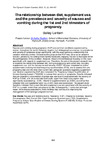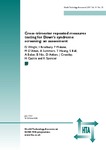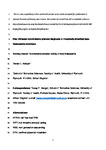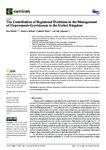The relationship between diet, supplement use, and the prevalence and severity of nausea and vomiting during the 1st and 2nd trimesters of pregnancy
| dc.contributor.author | Lentern, B. | |
| dc.date.accessioned | 2022-12-23T19:14:12Z | |
| dc.date.available | 2022-12-23T19:14:12Z | |
| dc.date.issued | 2022 | |
| dc.identifier.citation |
Lentern, B. (2022) 'The relationship between diet, supplement use, and the prevalence and severity of nausea and vomiting during the 1st and 2nd trimesters of pregnancy', The Plymouth Student Scientist, 15(2), pp. 464-487. | en_US |
| dc.identifier.issn | 1754-2383 | |
| dc.identifier.uri | http://hdl.handle.net/10026.1/20109 | |
| dc.description.abstract |
Nausea and vomiting during pregnancy (NVP) are common conditions experienced by women throughout the world. However, despite their widespread occurrence, the prevalence and severity of symptoms range significantly, with the exact aetiology underpinning this variation relatively unclear. Several studies propose that NVP may serve as an adaptive function, protecting the embryo from harmful foodstuffs, implying that diet is implicated within the pathogenesis of the condition. However, there is limited literature focusing on this topic, specifically with regards to supplement use. Therefore, the aim of the present research was to examine the relationship between diet, both pre-pregnancy and current diet, including supplement use, and the prevalence and severity of NVP. Women completed an online questionnaire involving two food frequency questionnaires (FFQ), one to assess their pre-pregnancy diet and the other their current diet, alongside questions regarding supplement use. Women experiencing NVP also completed the Pregnancy Unique Quantification of Emesis Scoring System (PUQESS) to assess their severity of symptoms. Results indicated that pre-pregnancy consumption of pulses was significantly associated with the severity of NVP (p=0.046), with all current diet food stuffs, apart from meat consumption also significantly associated (p=<0.05). Vitamin D supplementation (p=0.002), as well as first trimester folic acid supplementation (p=<0.001) were also associated. The present study therefore indicates that current diet and supplement use are associated with the severity of NVP to a greater extent than pre-pregnancy diet. Subsequently, if conducted amongst larger, more diverse populations, these findings may contribute to improving the management of NV amongst pregnant women. | en_US |
| dc.language.iso | en | en_US |
| dc.publisher | University of Plymouth | en_US |
| dc.rights | Attribution 3.0 United States | * |
| dc.rights.uri | http://creativecommons.org/licenses/by/3.0/us/ | * |
| dc.subject | Nausea and Vomiting during Pregnancy (NVP) | en_US |
| dc.subject | Pregnancy Sickness | en_US |
| dc.subject | Severity | en_US |
| dc.subject | Pre-pregnancy Diet | en_US |
| dc.subject | Current Diet | en_US |
| dc.subject | Food Frequency Questionnaire (FFQ) | en_US |
| dc.subject | Supplements | en_US |
| dc.subject | Pregnancy Unique Quantification of Emesis Scoring System (PUQESS) | en_US |
| dc.subject | Embryo Protection Hypothesis (EPH) | en_US |
| dc.title | The relationship between diet, supplement use, and the prevalence and severity of nausea and vomiting during the 1st and 2nd trimesters of pregnancy | en_US |
| dc.type | Article | en_US |
| plymouth.issue | 2 | |
| plymouth.volume | 15 |






